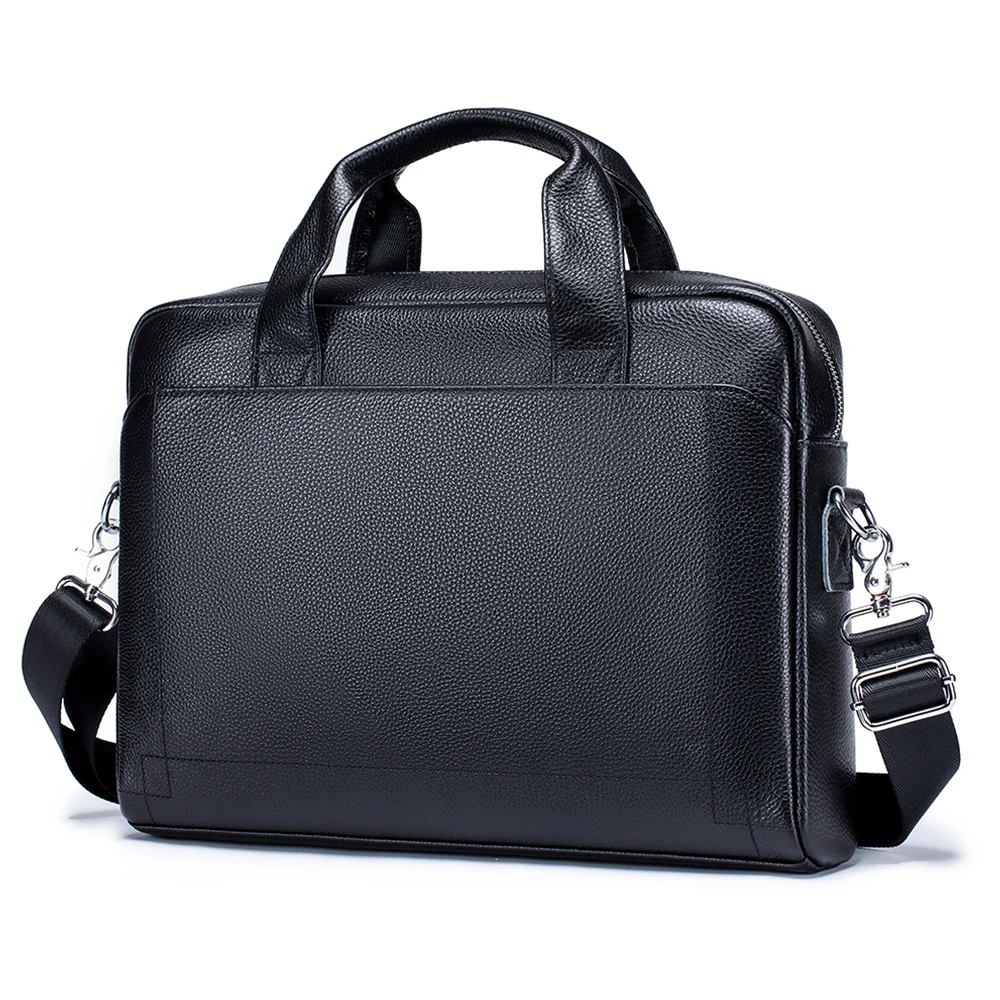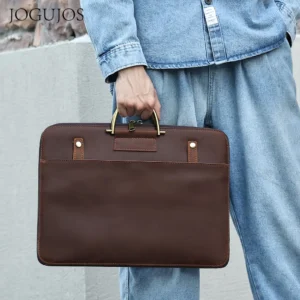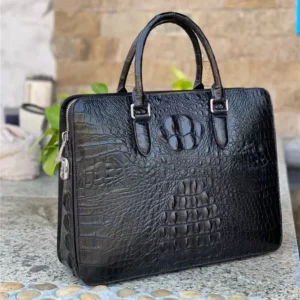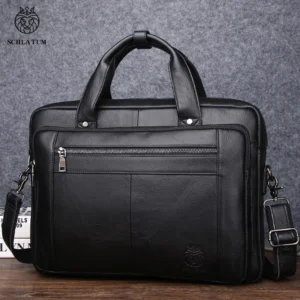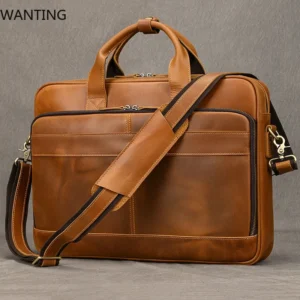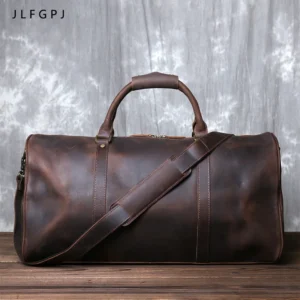Introduction
A classic leather briefcase stands as one of the few professional accessories that seamlessly blends function and status. More than just a container for documents, it’s a statement piece that communicates attention to detail and appreciation for enduring craftsmanship. What makes a briefcase truly “classic” isn’t merely its shape, but rather a harmonious combination of premium materials, thoughtful design, and functional elements that have remained relevant despite changing professional environments.
Throughout history, briefcases have evolved from simple document carriers used by lawyers and businessmen to versatile professional companions accommodating modern technology. Yet the hallmarks of quality have remained remarkably consistent. The weight of a substantial handle, the subtle aroma of quality leather, and the satisfying click of a well-engineered clasp continue to signify excellence.
This guide will navigate you through the essential features that define quality craftsmanship in leather briefcases. Understanding these elements not only helps you make a more informed purchasing decision but also appreciates why these items often become treasured possessions that develop character over decades of use. A well-crafted leather briefcase isn’t merely purchased—it’s invested in, with the expectation that its functionality and beauty will only improve with time. Those who understand choosing timeless classic leather briefcases recognize that the initial quality directly determines decades of satisfaction.
1. Premium Leather Quality: The Foundation of Excellence
The single most important element of any leather briefcase is, unsurprisingly, the quality of its leather. This foundational material determines virtually every aspect of the briefcase’s performance over time—its durability, how it looks after years of use, its resistance to environmental factors, and even how it feels in your hands on day one versus year ten.
Quality leather provides a unique combination of strength, flexibility, and beauty that synthetic materials simply cannot replicate. When examining a potential briefcase purchase, understanding leather quality becomes your first and most critical assessment. The finest briefcases use leathers that are carefully selected, properly tanned, and expertly finished to ensure they not only look beautiful when new but develop character and patina with use.
Premium leather has distinctive characteristics that you can identify through both sight and touch:
– Natural variations in texture and grain pattern
– Substantial weight that feels solid but not stiff
– Smooth, consistent coloring without spotty dye application
– A rich, natural scent (not chemical or artificially fragrant)
– Visible pores and subtle natural markings that confirm authenticity
While high-quality leather typically commands a higher price point, this cost difference directly translates to longer useful life, better aging characteristics, and superior everyday performance. Understanding defining best leather briefcases requires recognizing these quality indicators that separate exceptional products from merely adequate ones.
1.1 Understanding Leather Grades: From Full-Grain to Bonded
Not all leather is created equal, and the differences between grades significantly impact a briefcase’s quality, durability, and aesthetic development. Here’s what you need to know about the leather hierarchy:
Full-Grain Leather:
The highest quality option, full-grain leather comes from the top layer of the hide and retains its natural grain pattern and pores. It hasn’t been sanded or buffed to remove imperfections, which means it:
– Develops the richest patina over time
– Offers maximum durability (often lasting 15-20 years with proper care)
– Provides natural water resistance due to tight fiber structure
– Contains unique natural markings that ensure no two pieces are identical
Top-Grain Leather:
The second-highest quality grade, top-grain leather has been lightly sanded to remove imperfections and then coated with a finish. This means:
– More uniform appearance than full-grain
– Thinner and more pliable than full-grain
– Good durability but typically less than full-grain
– More resistant to stains but less likely to develop a natural patina
Genuine Leather:
Despite its name suggesting authenticity, “genuine leather” actually indicates lower quality. It’s made from the hide layers remaining after top-grain is removed:
– Much less durable than higher grades
– Often treated with heavy dyes and finishes to mask poor quality
– Tends to wear out rather than wear in
– May begin peeling or cracking within just a few years
Bonded Leather:
The lowest quality option, essentially the “particle board” of leather products. It consists of leather scraps and fibers bonded together with adhesives:
– Likely to crack, peel, and deteriorate quickly
– Often has an artificial or chemical smell
– Cannot develop patina and typically doesn’t age gracefully
– Should be avoided entirely in premium briefcases
For professional briefcases meant to last years or even decades, full-grain messenger bag designs and classic briefcases made with top-quality leathers represent the wisest investment. The difference becomes increasingly apparent with each passing year of use.
1.2 Tanning Methods and Their Impact on Quality
The process used to convert raw animal hide into durable, usable leather significantly affects the final product’s characteristics. Understanding these methods helps you assess how a briefcase will perform over its lifetime.
Vegetable Tanning:
This traditional method uses tannins from plant sources like tree bark and leaves to treat the leather. Vegetable-tanned leather:
– Develops a gorgeous honey-to-dark-brown patina over time
– Has a distinctive natural smell that many find pleasant
– Offers excellent structural stability and firmness
– Typically feels stiffer initially but softens beautifully with use
– Is environmentally friendlier than chrome tanning
– Takes longer to produce (often months versus days)
Chrome Tanning:
This modern process uses chromium salts and other chemicals to create leather more quickly. Chrome-tanned leather:
– Is typically softer and more pliable from the beginning
– Offers greater water resistance
– Comes in a wider variety of colors since it accepts dyes more readily
– Generally won’t develop the same deep patina as vegetable-tanned leather
– Tends to have a more uniform appearance
Hybrid Tanning:
Many premium briefcases use leather that undergoes both processes to capture beneficial properties from each method:
– The stability and patina development of vegetable tanning
– The softness and water resistance of chrome tanning
– Often combines the best qualities of both methods
For a premium briefcase intended for daily professional use in varying conditions, vegetable-tanned or hybrid-tanned leather typically offers the ideal balance of immediate tactile pleasure and long-term character development. The tanning method directly influences how the briefcase will feel, look, and perform decades after purchase.
2. Craftsmanship Indicators: Construction Details That Matter
Beyond the quality of leather itself, how that leather is transformed into a functional briefcase determines its longevity, functionality, and aesthetic appeal. True craftsmanship reveals itself in construction details that might not be immediately obvious but make substantial differences in daily use and long-term durability.
When evaluating a briefcase’s construction quality, pay attention to these key indicators:
- Precision of cutting: Edges should be clean and straight, with pieces that align perfectly
- Stitching regularity: Even, tight stitches without puckering or loose threads
- Edge finishing: Smooth, sealed edges that won’t fray or separate over time
- Panel alignment: All parts should meet precisely without gaps or overlaps
- Interior construction: Similar attention to detail inside as outside
- Symmetry: Both sides should mirror each other in dimensions and details
Quality construction doesn’t always mean the briefcase was entirely handmade. Many premium manufacturers combine traditional handcrafting for critical areas with precision machinery for consistency. What matters more than the specific methods is the thoughtfulness and care evident in the final product.
A well-constructed classic leather briefcase might cost more initially, but that investment directly translates to years or decades of additional useful life. Construction quality becomes particularly apparent at stress points—handles, corners, closures—where inferior craftsmanship fails first.
2.1 Stitching Excellence: The Mark of Superior Craftsmanship
Stitching is the literal thread that holds a briefcase together, and its quality directly impacts both appearance and durability. Premium briefcases feature distinctive stitching characteristics worth identifying:
Saddle Stitching:
Often found in the highest quality briefcases, saddle stitching is done by hand and creates a lock at each stitch point, meaning:
– If one stitch breaks, the entire seam won’t unravel
– Each stitch passes through both pieces of leather twice
– The result is exceptionally strong and durable
– It generally requires significant skill and time to execute properly
Lock Stitching:
The most common machine stitching method in quality briefcases:
– Creates a secure interlocking stitch between two threads
– Produces very consistent, evenly spaced stitches
– Is still very durable when properly executed
– Allows for efficient production while maintaining quality
When examining stitching quality, look for:
– Even tension throughout (no loose or overly tight areas)
– Consistent spacing between stitches
– Straight lines that don’t waver
– Small, precise stitches (generally 5-8 stitches per inch is ideal)
– Reinforced stitching at stress points
– Thread color that complements rather than contrasts with the leather
The thread material itself also matters. Quality briefcases typically use heavy-duty threads like waxed linen or polyester bonded threads that resist fraying and breaking. These might be slightly thicker and more noticeable than threads in cheaper products, signaling their strength and durability.
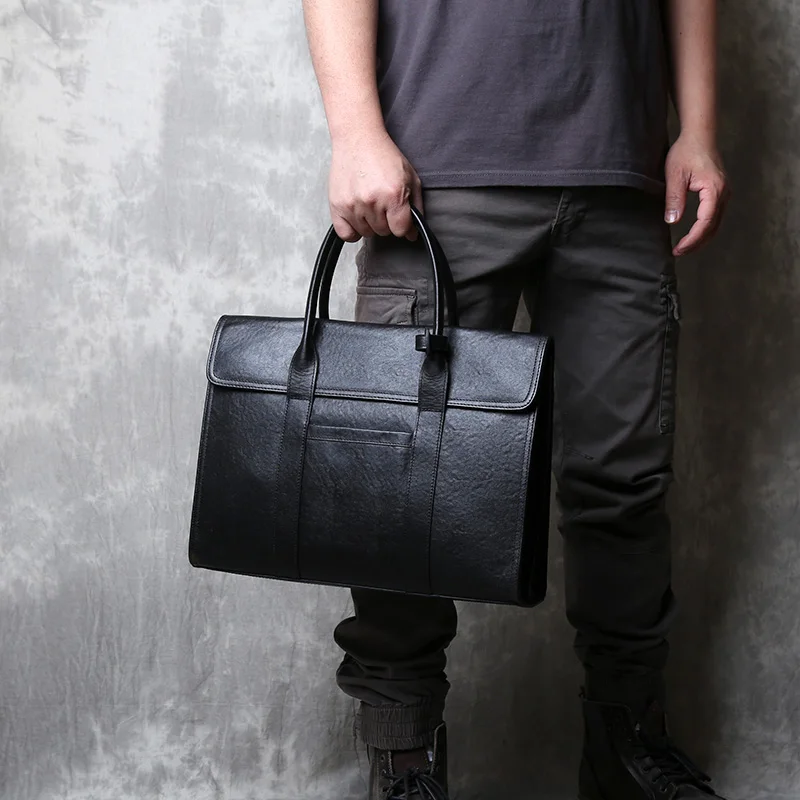
2.2 Hardware That Stands the Test of Time
The metal components of a briefcase—often called hardware—are both functional necessities and opportunities for distinctive design. Quality hardware elevates a briefcase from merely functional to truly exceptional.
Premium briefcases typically feature hardware that is:
– Made from solid brass, stainless steel, or high-grade nickel
– Substantial in weight and feel
– Smoothly operational without sticking or catching
– Securely attached with reinforced mounting points
– Finished to resist tarnishing and corrosion
– Designed to complement the briefcase’s overall aesthetic
Key hardware components to evaluate include:
Closures and Clasps:
– Should operate smoothly without excessive force
– Need to align perfectly when the briefcase is closed
– Must secure reliably without coming undone accidentally
– Often feature distinctive detailing that showcases craftsmanship
Hinges and Joints:
– Should move freely without looseness or wobble
– Need to be securely attached to prevent pulling away from leather
– Must be properly sized for the briefcase’s dimensions and weight
Feet and Corner Protectors:
– Should be properly positioned to protect the leather from wear
– Need to be securely attached without visible gaps
– Must be made of durable materials that won’t bend or break
Zippers (when present):
– Look for renowned brands like YKK Excella or RiRi
– Should glide smoothly without catching
– Need substantial pull tabs that are easy to grip
– Must be properly installed with backing to prevent leather damage
Quality hardware represents a significant portion of a briefcase’s production cost, yet manufacturers who invest in these components create products that function flawlessly for decades rather than years. The difference becomes most apparent in daily use, where premium hardware operates with a satisfying precision that lesser components cannot match.
3. Designed for Durability: Structural Features to Look For
A truly quality briefcase is engineered from the inside out to withstand years of daily use while maintaining its shape, function, and appearance. This durability doesn’t happen by accident—it results from intentional design decisions that address the specific stresses briefcases endure.
Key structural design elements in premium briefcases include:
- Internal framing: Quality briefcases often contain hidden structural elements that maintain shape
- Reinforced bottoms: The base typically bears the most weight and needs additional support
- Strategic reinforcement: Extra material layers in high-stress areas
- Load-distributing design: Weight is evenly spread rather than concentrated at single points
- Movement accommodation: Flexibility where needed, rigidity where required
These structural elements might add slight weight to the briefcase, but they dramatically extend its useful life by preventing the sagging, bulging, and distortion that plague lesser bags after regular use.
The ultimate test of structural design is how a briefcase performs when fully loaded. A well-engineered briefcase maintains its shape and proportions even when filled to capacity, while inferior designs show immediate stress signs like bulging sides or distorted handles. Finding durable leather briefcase options means looking beyond surface appearance to understand the engineering beneath.
3.1 Stress Point Reinforcement: Where Quality Is Non-Negotiable
Every briefcase has specific areas that endure more strain than others. How these stress points are reinforced separates briefcases that last decades from those that fail within years.
Critical stress points requiring special attention include:
Handle Attachments:
The point where handles connect to the main body bears tremendous weight with every lift. Quality reinforcement includes:
– Multiple layers of leather creating extra strength
– Rivets or specialized hardware securing through all layers
– Hidden reinforcement straps extending down the briefcase sides
– Box stitching or other specialized stitching patterns for load distribution
Shoulder Strap Connections:
These points experience both weight and dynamic movement stresses:
– Should feature metal hardware anchored to reinforced leather patches
– Often include D-rings or equivalent hardware that allows natural movement
– Need substantial backing to distribute weight across a larger area
– Should be positioned to balance the briefcase when carried
Corners and Edges:
These areas endure constant abrasion and impact:
– Premium briefcases often feature metal corner protectors or hidden reinforcement
– Additional leather layers may be invisibly added for strength
– Edge construction often includes multiple folded layers rather than a single piece
– Specialized edge treatments seal and protect against fraying or separation
To test reinforcement quality, gently flex and tug at these stress points—quality briefcases will feel solid and unyielding, while inferior construction will show immediate give or strain. These reinforcement details may add slightly to a briefcase’s weight but dramatically extend its useful life.
3.2 Edge Treatment and Finishing: Details That Define Quality
The edges of leather pieces represent vulnerable points in any briefcase’s construction. How these edges are treated significantly impacts both aesthetics and longevity.
Premium briefcases typically feature one of these edge treatments:
Burnishing:
– Edges are polished to a smooth finish using friction and heat
– Creates a sealed, water-resistant edge that won’t separate or fray
– Often has a slightly darker color than the main leather surface
– Indicates hand-finishing and attention to detail
Edge Painting:
– Edges receive a protective coating that seals and finishes
– Creates a clean, uniform appearance that can match or contrast with leather
– Protects exposed leather from moisture absorption
– Requires skilled application to avoid cracking or peeling
Edge Folding:
– Leather edges are folded under and secured, hiding raw edges entirely
– Creates a clean, finished appearance with no exposed leather edge
– Adds strength through multiple layers
– Requires significant skill to execute neatly, especially on curves
Quality edge work should be consistent throughout the briefcase—every edge, no matter how small or hidden, receives the same careful treatment. This consistency reflects the maker’s commitment to comprehensive quality rather than just surface appearance.
Over time, edge quality becomes increasingly apparent. While inferior edges fray, separate, or absorb moisture, properly finished edges maintain their integrity and appearance through years of use.
4. Functionality & Organization: Interior Design Excellence
A briefcase’s exterior might capture immediate attention, but its interior organization determines daily usability and satisfaction. The finest briefcases balance classic simplicity with practical organization that accommodates modern professional needs.
The hallmark of superior interior design is thoughtful purpose—every pocket, divider, and compartment exists for a specific reason rather than merely to add features. Premium briefcases typically avoid excessive compartmentalization that adds bulk and weight without practical benefit.
Well-designed interiors typically include:
– A main document section sized precisely for standard paper formats
– A secure, padded compartment for electronic devices
– Strategically placed smaller pockets for frequently accessed items
– Organization features that maintain accessibility without adding bulk
– Lining materials that protect contents while complementing the exterior
The best interior designs remain relevant despite technological changes—they accommodate both traditional paper documents and modern devices without feeling dated or overspecialized. This adaptability is particularly important in classic laptop briefcase designs, which must balance timeless aesthetics with modern functionality.

4.1 Essential Compartments for Professional Efficiency
Effective interior organization begins with understanding the core items professionals carry daily. The most functional briefcases include specific compartments designed around these essentials:
Document Storage:
The foundation of any briefcase, this compartment should:
– Accommodate standard paper sizes without folding (A4, letter, or legal)
– Feature sufficient width for multiple file folders or documents
– Include dividers to separate and organize materials
– Maintain document flatness to prevent creasing or damage
Laptop/Tablet Protection:
Modern briefcases should include dedicated electronic device storage that:
– Provides adequate padding on all sides, especially the bottom
– Secures the device to prevent shifting during transport
– Accommodates common device sizes (typically 13-15.6 inches)
– Features soft lining material to prevent scratches
Small Item Organization:
Efficiently designed smaller compartments should include:
– Pen holders positioned for easy access
– Card pockets for business cards and credit cards
– A phone pocket sized appropriately for modern devices
– Key clips or pockets to prevent key damage to other contents
– Zippered security pockets for valuable small items
Quick Access Storage:
Professional efficiency often requires immediate access to certain items:
– External pockets that don’t require opening the main compartment
– Strategically positioned pockets for items needed on the go
– Secure yet easily accessible storage for travel documents
The best leather briefcase document compartments balance comprehensive organization with practical accessibility. Excessive dividers and pockets can actually reduce functionality by making items harder to locate and retrieve. Premium briefcases strike this balance thoughtfully, with every organizational element serving a clear purpose.
4.2 Material Choices for Interior Excellence
While exterior leather quality rightfully receives significant attention, interior materials play an equally important role in overall briefcase quality and functionality:
Lining Materials:
The best briefcases feature interior linings that are both functional and beautiful:
– Premium cotton twill provides durability with a soft touch
– Pigskin or goatskin offers exceptional durability and luxury
– Microsuede combines softness with resistance to marks and scratches
– Waterproof or water-resistant linings protect contents from accidental spills
Interior Leather:
Many premium briefcases use leather for interior dividers and organizational elements:
– Often slightly thinner than exterior leather for reduced weight
– Typically vegetable-tanned for softness against contents
– Sometimes uses contrasting colors for visual appeal and easier content location
– Shows the same attention to edge finishing as exterior components
Color Considerations:
Interior color choices aren’t merely aesthetic decisions:
– Lighter colored interiors make contents easier to see and locate
– Contrasting colors help differentiate compartments
– Color coordination with exterior leather creates a cohesive design
– Color-blocking can direct users to different functional areas
Attachment Methods:
How interior elements connect to the main structure affects durability:
– Quality interiors have pockets and dividers securely stitched, not merely glued
– All attachment points should be reinforced to prevent tearing
– Interior seams should receive the same careful stitching as exterior ones
– Materials should be attached in ways that accommodate movement without stress
A truly premium briefcase maintains its commitment to quality in these interior elements rather than cutting costs where they’re less visible. This comprehensive approach to quality ensures that the briefcase functions as beautifully as it looks, even after years of daily use.
5. Carrying Comfort: Ergonomic Design Elements
Even the most beautiful briefcase will disappoint if it’s uncomfortable to carry. Premium briefcases incorporate ergonomic design elements that enhance comfort without compromising aesthetics or durability.
These comfort-enhancing features include:
- Balanced weight distribution: The briefcase should hang evenly when carried, without tipping forward or backward
- Properly sized handles: Handle dimensions should accommodate average hand sizes with room for gloves in cold weather
- Strategic padding: Subtle cushioning in handles and straps improves comfort during extended carrying
- Appropriate proportions: The briefcase’s dimensions should work harmoniously with average human body proportions
- Adaptable carrying options: Multiple ways to carry accommodate different situations and preferences
The best briefcases achieve comfort naturally through thoughtful design rather than through obvious padding or sporty elements that would compromise classic aesthetics. This subtle ergonomic integration reflects sophisticated design thinking that considers both form and function.
5.1 Handle Construction and Attachment Methods
Handles are perhaps the most frequently used component of any briefcase, making their design and construction critically important to both comfort and durability:
Handle Materials:
Quality handles typically feature:
– Multiple layers of leather for strength and durability
– Core reinforcement materials when needed for additional structure
– Proper thickness—neither too thin (uncomfortable) nor too bulky (unwieldy)
– Edges that are carefully finished to prevent irritation during carrying
Attachment Methods:
How handles connect to the briefcase body determines their strength and comfort:
– Superior briefcases often use “buried” attachments where the handle straps extend well below the visible connection point
– Rivets may reinforce stitching at critical connection points
– Multiple rows of stitching distribute weight across a larger area
– Some designs incorporate hidden reinforcement plates for additional strength
Ergonomic Considerations:
Handle comfort depends on thoughtful dimensional decisions:
– The distance between handles should allow comfortable hand insertion without excessive gap
– Handle drop (height above the briefcase) should allow comfortable carrying without the briefcase hitting the body
– Handle shape often includes a slight curve that naturally fits the hand’s contour
– The underside of handles frequently features a slightly rounded edge to prevent cutting into fingers
Quality handles develop character with use, often becoming more comfortable as they gently conform to the user’s grip pattern. This personalization represents one of the distinctive advantages of premium leather goods.
5.2 Shoulder Straps: Balancing Convenience and Style
While traditional briefcases were designed primarily for hand carrying, many modern classic designs incorporate shoulder straps that maintain professional appearance while adding carrying convenience:
Detachable vs. Permanent Design:
Premium briefcases typically feature:
– Detachable straps that allow traditional hand-carried presentation when appropriate
– Secure attachment mechanisms that won’t come loose accidentally
– Clean design that looks intentional whether the strap is attached or removed
– Elegant storage solution for the detached strap
Material and Construction:
Quality shoulder straps feature:
– The same leather grade as the briefcase body for consistent aging
– Substantial width (typically 1-1.5 inches) to distribute weight comfortably
– Carefully finished edges to prevent clothing damage
– Length adjustment mechanisms that stay securely in position
Attachment Hardware:
How the strap connects impacts both function and aesthetics:
– Premium hardware matches or complements other briefcase metal components
– Swivel mechanisms allow natural movement without twisting
– Attachment points are reinforced to prevent tearing or pulling
– Clasps operate smoothly while maintaining secure connection
The best shoulder straps achieve convenience without compromising the briefcase’s professional appearance. They don’t call attention to themselves but rather serve their function elegantly while maintaining the briefcase’s classic character.
6. Aesthetic Excellence: Design Elements of Timeless Appeal
While functionality drives most briefcase design decisions, aesthetic excellence separates truly exceptional pieces from merely functional ones. Briefcases with timeless appeal typically embody specific design principles:
- Balanced proportions: Dimensions relate harmoniously to each other rather than appearing stretched or compressed
- Visual restraint: Ornamentation serves purpose rather than mere decoration
- Material honesty: Quality materials are showcased rather than disguised
- Considered details: Small elements like stitching pattern and hardware design receive careful attention
- Cohesive design language: All elements speak with a unified visual voice
These design principles typically result in briefcases that avoid trendy styling cues in favor of time-tested aesthetics. While fashion-forward briefcases might capture immediate attention, classically designed pieces maintain their appeal across decades and diverse professional environments.
The finest briefcases achieve a distinctive presence without resorting to logos or obvious branding elements. Instead, their quality and design speak for themselves, creating recognition through excellence rather than external identifiers. Understanding how leather briefcases enhance look provides insight into why these accessories remain powerful professional signifiers.
6.1 Patina Development: The Living Beauty of Quality Leather
Perhaps the most distinctive characteristic of premium leather briefcases is their ability to develop character over time. This natural aging process, called patina development, transforms the briefcase from a manufactured product into a unique personal artifact:
Patina Characteristics:
This desirable aging process typically includes:
– Gradual deepening of color, often creating rich honey and amber tones
– Subtle darkening in areas of frequent handling
– Development of a gentle surface luster from natural oils in the leather
– Slight softening of originally firm leather
– A unique character that reflects the owner’s specific use patterns
Leather Factors Affecting Patina:
Not all leather develops patina equally:
– Vegetable-tanned full-grain leather develops the most pronounced, desirable patina
– Minimally finished leathers allow more natural aging than heavily coated surfaces
– Natural colors typically develop more noticeable patina than dyed leathers
– Different leather types (cowhide, buffalo, etc.) develop distinctively different patina
Positive vs. Negative Aging:
While patina is desirable, not all aging is positive:
– Patina involves the leather becoming more beautiful while maintaining integrity
– Negative aging includes cracking, peeling, or structural deterioration
– Quality briefcases age gracefully without compromising function
– Proper care enhances positive patina development while preventing negative aging
This unique ability to improve aesthetically with use separates fine leather goods from virtually all other categories of professional accessories. A well-used quality briefcase often appears more distinguished than a new one—a characteristic that synthetic materials cannot replicate.
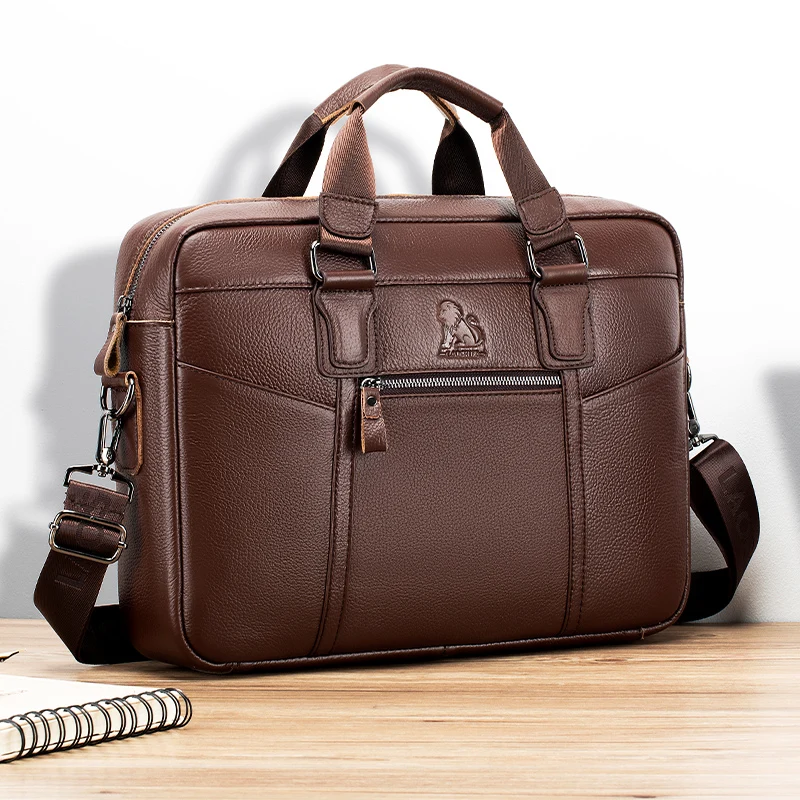
6.2 Hardware Aesthetics: Balancing Function and Style
Metal components serve essential functional purposes while also contributing significantly to a briefcase’s visual identity. Premium briefcases feature hardware that achieves this dual purpose elegantly:
Finish Options:
Hardware finishes create distinctive aesthetic impressions:
– Brass offers a warm, traditional appearance that develops character with use
– Nickel provides a cooler, more contemporary look with excellent durability
– Antiqued or brushed finishes hide minor scratches and fingerprints
– Polished finishes create a more formal, precise appearance
Visual Proportions:
Hardware size and positioning affects overall aesthetics:
– Quality hardware is proportionally sized to the briefcase’s overall dimensions
– Placement appears intentional rather than arbitrary
– Hardware elements relate visually to each other through consistent design language
– Visible hardware typically strikes a balance between presence and restraint
Design Consistency:
Hardware elements in premium briefcases maintain design coherence:
– All visible hardware shares compatible design vocabulary
– Details like edge beveling or surface texturing remain consistent
– Functional elements (clasps, zippers) relate visually to non-functional elements (feet, corners)
– Every element appears to belong to the same design family
The most elegant briefcases achieve hardware integration that feels inevitable rather than applied—each element appears to be exactly what that position requires, neither excessive nor insufficient. This design coherence contributes significantly to the briefcase’s overall impression of thoughtful creation.
7. Size and Proportions: Finding Your Perfect Match
Briefcase dimensions significantly impact both functionality and professional presentation. While personal preferences vary, certain size considerations apply universally:
Standard Dimensions:
While slight variations exist between brands, classic briefcases typically fall within these ranges:
– Width: 15-17 inches (38-43 cm)
– Height: 11-12 inches (28-30 cm)
– Depth: 3-5 inches (7.5-12.5 cm)
Functional Considerations:
Size selection should consider specific professional needs:
– Document capacity requirements (volume of papers typically carried)
– Electronic device dimensions (laptop or tablet size)
– Commuting method (public transit may favor slightly smaller profiles)
– Physical proportions (the briefcase should look appropriately scaled to the carrier)
Professional Context:
Different environments have different size expectations:
– Traditional professions like law often favor slightly larger, more substantial briefcases
– Creative fields might embrace slimmer, more minimalist profiles
– Technical roles requiring extensive equipment may need expanded capacity
Finding your ideal dimensions involves balancing these practical considerations with aesthetic preferences. The best briefcase size makes a positive statement while accommodating daily needs without excess bulk. Understanding large slim leather briefcase perfect size options helps determine the ideal balance for your specific needs.
Men's Classic Leather Briefcase, Slim Leather Laptop Briefcase, Slim Leather Portfolio Briefcase
$93.67 Select options This product has multiple variants. The options may be chosen on the product pageClassic Laptop Briefcase, Men's Classic Leather Briefcase, Slim Leather Attache Case
Price range: $353.50 through $360.81 Select options This product has multiple variants. The options may be chosen on the product pageBlack Leather Briefcase, Leather Document Bag, Men's Classic Leather Briefcase
Genuine Crocodile Leather Executive Briefcase with Password Lock – Premium Business Document Carrier$1,201.87 Select options This product has multiple variants. The options may be chosen on the product pageBlack Leather Briefcase, Classic Laptop Briefcase, Men's Classic Leather Briefcase, Slim Leather Laptop Briefcase
$228.72 Select options This product has multiple variants. The options may be chosen on the product pageBrown Leather Briefcase, Classic Laptop Briefcase, Crazy Horse Leather Satchel, Men's Classic Leather Briefcase
Price range: $172.15 through $200.02 Select options This product has multiple variants. The options may be chosen on the product pageCrazy Horse Leather Satchel, Full Grain Messenger Bag, Men's Leather Satchel
$430.41 Select options This product has multiple variants. The options may be chosen on the product page
7.1 Weight Considerations: The Balance of Substance and Practicality
Briefcase weight represents an important but often overlooked factor in both perceived quality and daily usability:
Typical Weight Ranges:
Classic leather briefcases generally fall within these ranges:
– Lightweight: 2.5-3.5 pounds (1.1-1.6 kg)
– Medium: 3.5-4.5 pounds (1.6-2 kg)
– Substantial: 4.5+ pounds (2+ kg)
Weight Contributors:
Several factors determine a briefcase’s empty weight:
– Leather thickness (thicker, fuller-bodied leather weighs more)
– Hardware amount and type (solid brass is heavier than aluminum)
– Internal structure (framing adds weight but maintains shape)
– Reinforcement elements (additional leather layers at stress points)
Finding the Right Balance:
The ideal weight depends on personal preference and use patterns:
– Daily long-distance commuters might prioritize lighter options
– Primarily office-to-meeting use cases can accommodate more substantial weights
– The feeling of quality often correlates with some weight, but excessive heaviness becomes impractical
Quality briefcases achieve appropriate weight—enough substance to feel properly made without unnecessary bulk. The weight should feel like a natural consequence of quality materials rather than arbitrary heaviness. When filled, a well-designed briefcase distributes this weight comfortably without pressure points or imbalance.
8. Closure Systems: Security Meets Convenience
How a briefcase opens and closes significantly impacts both security and daily usability. Different closure systems offer distinct advantages and aesthetic statements:
Traditional Lock Mechanisms:
Classic briefcases often feature:
– Frame closures with turn-lock hardware
– Key locks for additional security
– Satisfying mechanical operation with precise engineering
– A formal, structured appearance
Flap-Over Designs:
Many classic briefcases use a top flap secured by:
– Brass turn locks or push locks
– Hidden magnetic closures
– Buckle straps (functional or decorative)
– A slightly less formal but still professional presentation
Zipper Systems:
Modern classic designs might incorporate:
– Premium metal zippers (YKK Excella or similar quality)
– Twin-zipper designs allowing opening from either end
– Gusseted zipper paths that permit full opening
– A contemporary appearance while maintaining professionalism
Hybrid Closures:
Some innovative designs combine multiple systems:
– Zippered main compartment with buckled front pockets
– Magnetic closures with decorative buckle details
– Hidden security features behind traditional-appearing closures
– Maximum functionality while maintaining classic aesthetics
The ideal closure system balances several factors: security appropriate to contents, convenience for frequent access, mechanical reliability, and aesthetic coherence with the overall design. Premium briefcases feature closure systems that operate with precision and create a satisfying tactile experience that reinforces quality perception.
9. Investment Value: Why Quality Briefcases Stand the Test of Time
Unlike many professional accessories that quickly become obsolete or worn out, a truly quality leather briefcase represents a genuine long-term investment:
Financial Perspective:
Quality briefcases often demonstrate superior economics over time:
– Initial cost divided by years of use (often 10-20) results in very reasonable annual expense
– Reduced replacement frequency compared to lower-quality alternatives
– Potential for professional advancement through appropriate presentation
– Possible appreciation for certain collector-quality pieces
Practical Longevity:
Several factors contribute to extended useful life:
– Reparability when components eventually wear out
– Design that remains professionally appropriate across changing fashion cycles
– Functionality that accommodates evolving professional needs
– Materials that improve aesthetically with proper use
Professional Advantage:
Beyond practical considerations, quality briefcases offer:
– Consistent professional presentation that builds personal branding
– Subtle communication of attention to detail and quality standards
– Confidence that comes from carrying appropriate tools
– Freedom from worry about premature failure or inappropriate appearance
Understanding how choose perfect leather briefcase involves recognizing this investment perspective. While quality never comes cheaply, the value equation changes dramatically when viewed across the entire ownership timeline. A briefcase that costs three times more but lasts five times longer while looking better throughout represents genuine value despite its higher initial price.
10. What Makes a Briefcase “Classic”? Timeless Design Principles
While briefcase styles have evolved over decades, certain design principles consistently define “classic” pieces that transcend temporary trends:
The defining characteristics of classic briefcase design include:
Proportional Harmony:
Classic designs feature dimensions that relate logically to each other and to human proportions. Typically, width exceeds height by approximately 30-40%, while depth remains modest relative to both.
Visual Balance:
Elements like handles, hardware, and compartments are positioned to create visual equilibrium rather than appearing top-heavy, side-weighted, or otherwise imbalanced.
Structural Honesty:
Classic designs showcase their construction methods rather than hiding them, with visible stitching, edge work, and joinery becoming design elements themselves.
Material Focus:
The leather itself remains the star, with design choices that showcase rather than obscure the material’s natural beauty and character.
Restrained Detailing:
Embellishments serve functional purposes or highlight construction excellence rather than merely decorating surfaces.
These principles appear consistently across decades of briefcase design, from mid-century examples to contemporary interpretations. While specific features evolve to accommodate changing professional needs (like laptop compartments), these fundamental design approaches remain remarkably consistent in truly classic pieces.
The most successful modern classic briefcases honor these traditions while subtly incorporating contemporary needs—achieving timelessness not through rigid adherence to historical models but through thoughtful application of enduring design principles.
11. How Does Proper Care Extend a Leather Briefcase’s Lifespan?
A quality leather briefcase can last decades, but this longevity depends significantly on proper care routines:
Regular maintenance should include:
Cleaning:
– Dust removal using a soft cloth weekly
– Gentle cleaning with appropriate leather cleaner quarterly
– Immediate attention to any stains or spills
– Avoiding ordinary household cleaners that damage leather
Conditioning:
– Application of quality leather conditioner 2-4 times annually
– More frequent conditioning in dry climates or with frequent use
– Using conditioners appropriate for the specific leather type
– Allowing adequate absorption time before using the briefcase
Storage:
– Storing empty rather than loaded when not in use
– Keeping in dust bags or pillowcases to allow leather breathing
– Maintaining moderate humidity levels (not too dry or damp)
– Avoiding direct sunlight or heat sources during storage
Common care mistakes that compromise longevity include:
– Over-conditioning, which can soften leather excessively
– Using inappropriate products like household oils or polishes
– Ignoring early signs of wear that could be easily repaired
– Storing in plastic, which traps moisture and promotes mold
Understanding how maintain leather briefcase helps ensure your investment continues performing beautifully for years. The small effort of regular maintenance yields substantial returns in extended useful life and improved appearance.
12. Are Vintage Leather Briefcases Worth Considering?
Vintage briefcases can represent excellent value and unique character, but careful assessment is essential:
Potential Benefits:
Quality vintage briefcases offer several advantages:
– Proven durability (they’ve already survived decades of use)
– Fully developed patina that would take years to achieve in a new piece
– Often superior materials compared to many modern options
– Distinctive character and potential conversation value
– Sometimes more affordable than comparable new briefcases
Evaluation Criteria:
When considering vintage pieces, assess:
– Structural integrity, especially at handles and stress points
– Leather condition (supple but not dried out or cracked)
– Hardware functionality (locks, hinges, clasps)
– Interior condition, which often deteriorates before exteriors
– Odor (musty smells may indicate mold or improper storage)
Restoration Potential:
Different issues have different repair potential:
– Dried leather can often be revitalized with proper conditioning
– Hardware can frequently be repaired or replaced by skilled craftspeople
– Stitching issues are usually repairable if the leather remains sound
– Interior damage often represents the most challenging restoration
Vintage briefcases demonstrate how quality principles discussed throughout this guide translate into actual longevity. A well-made briefcase from decades past that still functions beautifully provides tangible proof of quality construction’s value.
13. How Do Different Professions Influence Briefcase Selection?
Professional context significantly influences which briefcase features and styles are most appropriate:
Legal Professionals:
Attorneys and judges typically benefit from:
– Larger document capacity for case files and legal briefs
– Traditional styling that communicates established competence
– Secure closures for confidential materials
– Structured designs that maintain professional formality
Finance and Business:
Corporate professionals often prefer:
– Sleek, understated designs that communicate efficiency
– Secure document storage combined with technology accommodation
– Lightweight construction for frequent travel
– Hardware and details that convey precision without ostentation
Creative Professionals:
Those in design, media, and creative fields might choose:
– More distinctive leather colors or textures
– Less structured designs that communicate creative thinking
– Adaptable features for various media and presentation materials
– Contemporary interpretations of classic forms
Technology Professionals:
Those in technical roles often need:
– Enhanced protection for multiple electronic devices
– Expanded capacity for adapters, chargers, and peripherals
– Quick-access compartments for frequently used tools
– Durable construction to withstand varied work environments
The best briefcase for any professional balances industry expectations with personal preferences and specific daily requirements. By understanding the intersection of profession-specific needs and quality indicators, professionals can select briefcases that enhance rather than merely accompany their work.
14. When Is a Higher Price Justified for a Leather Briefcase?
Premium briefcases command significantly higher prices than average options, but several factors can justify this investment:
Material Quality Differences:
Higher prices are warranted when they secure:
– Full-grain leather from superior sources
– Thicker, more substantial leather cuts
– Traditional, time-intensive tanning methods
– Premium hardware with proper engineering
Construction Value:
Price premiums reflect production differences:
– More time-intensive construction methods
– Higher skilled labor investment
– Additional reinforcement and structural elements
– More precise cutting and assembly
Longevity Economics:
Higher initial costs may represent better long-term value through:
– Extended useful life (often 3-5× longer than average briefcases)
– Better aging characteristics (improving rather than deteriorating)
– Reparability when components eventually wear
– Retained professional appropriateness across fashion cycles
While premium pricing should correlate with these tangible quality differences, brand prestige alone doesn’t necessarily indicate superior quality. The most informed purchases come from understanding specific quality indicators rather than relying solely on brand name or price point.
For discerning professionals, a quality leather briefcase from Poise Porter represents not merely an accessory purchase but an investment in daily functionality, professional presentation, and long-term value. The mens classic leather briefcase collection exemplifies these principles of quality and craftsmanship.

